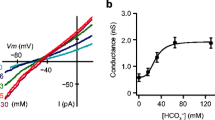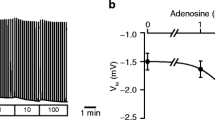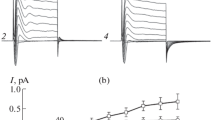Abstract
Nonselective Ca2+-sensitive cation channels in the basolateral membrane of isolated cells of the rat exocrine pancreas were investigated with the patch clamp technique. With 1.3 mmol/l Ca2+ on the cytosolic side, the mean openstate probabilityP o of one channel was about 0.5. In insideout oriented cell-excised membrane patches the substances diphenylamine-2-carboxylic acid (DPC), 5-nitro-2-(3-phenylpropylamino)-benzoic acid (NPPB) and 3′,5-dichlorodiphenylamine-2-carboxylic acid (DCDPC) were applied to the cytosolic side. These compounds inhibited the nonselective cation channels by increasing the mean channel closed time (slow block). 100 μmol/l of NPPB or DPC decreasedP o from 0.5 (control conditions) to 0.2 and 0.04, respectively, whereas 100 μmol/l of DCDPC blocked the channel completely. All effects were reversible. 1 mmol/l quinine also reducedP o, but in contrast to the abov mentioned substances, it induced fast flickering. Ba2+ (70 mmol/l) and tetraethylammonium (TEA+; 20 mmol/l) had no effects. We investigated also the stilbene disulfonates 4-acetamido-4′-isothiocyanatostilbene-2,2′-disulfonic acid (SITS), 4,4′-diisothiocyanatostilbene-2,2′-disulfonic acid (DIDS) and 4,4′-dinitro-2,2′-stilbenedisulfonate (DNDS). 10 μmol/l SITS applied to the cytosolic side increasedP o from 0.5 to 0.7 and with 100 μmol/l SITS the channels remained nearly permanently in its open state (P o≅1). A similar activation of the channels was also observed with DIDS and DNDS. These effects were poorly reversible. The stilbene disulfonates acted by increasing the channel mean open time. When the channel was inactivated by decreasing bath Ca2+ concentration to 0.1 μmol/l, addition of 100 μmol/l of SITS had no effect. Similarly, reducing bath Ca2+ concentration from 1.3 mmol/l in presence of 100 μmol/l SITS (channels are maximally activated) to 0.1 μmol/l, inactivated the channels completely. These results demonstrate, that SITS can only activate the channels in the presence of Ca2+. SITS had no effects, when applied to the extracellular side in outside out patches. In summary, the substances DPC, NPPB and DCDPC inhibit nonselective cation channels, where DCDPC has the most potent and NPPB the smallest effect; whereas SITS, DIDS and DNDS activate the channel when applied from the cytosolic side in the presence of Ca2+ ions.
Similar content being viewed by others
References
Argent BE, Arkle S, Gray MA, Greenwell JR (1987) Two types of calcium-sensitive cation channels in isolated rat pancreatic duct cells. J Physiol 386:82P
Barzilay M, Ship S, Cabantchik ZI (1979) Anion transport in red blood cells. I. Chemical properties of anion recognition sites as revealed by structure-activity relationships of aromatic sulfonic acids. Membr Biochem 2:227–254
Benzanilla F (1985) A high capacity data recording device based on a digital audio processor and video cassette recorder. Biophys J 47:437–441
Bevan S, Gray PTA, Ritchie JM, (1984) A calcium-activated cation-selective channel in rat culured Schwann cells. Proc R Soc Lond [Biol] 412:224–232
Boron WF, Boupaep EL (1983) Intracellular pH regulation in the renal proximal tubule of the salamander. Basolateral HCO3 transport. J Gen Physiol 81:53–94
Cabantchik ZI, Rothstein A (1972) The nature of the membrane sites controlling anion permeability of human red blood cells as determined by studies with disulfonic stilbene derivatives. J Membr Biol 10:311–330
Cabantchik ZI, Rothstein A (1974) Membrane proteins related to anion permeability of human red blood cells. J Membr Biol 15:207–226
Colquhoun D, Hawkes AG (1981) On the stochastic properties of single ion channels. Proc R Soc Lond [Biol] 211:205–235
Colquhoun D, Sigworth F (1983) Fitting and statistical analysis of single-channel recording. In: Sakmann B, Neher E (eds) Single channel recording. Plenum Press. New York London, pp 191–264
Colquhoun D, Neher E, Reuter H, Stevens CF (1981) Inward current channels activated by intracellular Ca in cultured cardiac cells. Nature 294:752–754
Cooper KE, Tang JM, Rae JL, Eisenberg RS (1986) A cation channel in frog lens epithelia responsive to pressure and calcium. J Membr Biol 93:259–269
Di Stefano A, Wittner M, Schlatter E, Lang HJ, Englert H, Greger R (1985) Diphenylamine-2-carboxylate, a blocker of the Cl−-conductive pathway in Cl−-transporting epithelia. Pflügers Arch 405:S95-S100
Dreinhöfer J, Gögelein H, Greger R (1988) Blocking effect of 5-nitro-2-(3-phenylpropylamino)-benzoate (NPPB) on Cl− channels in the colon carcinoma cells HT29. Pflügers Arch 411:R76
Eaton DC, Brodwick S (1979) Amino group reagents affect inactivation in squid axon. Biophys J 25:305a
Eaton DC, Brodwick MS, Oxford GS, Rudy B (1978) Arginine-specific reagents remove sodium channel inactivation. Nature 271:473–476
Findlay I, Dunne MJ, Ullrich S, Wollheim CB, Petersen OH (1985) Quinine inhibits Ca2+-independent K+ channels whereas tetraethylammonium inhibits Ca2+-activated K+ channels in insulin-secreting cells. FEBS Lett 185:4–8
Fröhlich O (1982) The external anion binding site of the human erythrocyte anion transporter: DNDS binding and competition with chloride. J Membr Biol 65:111–123
Frömter E, Ullrich KJ (1980) Effect of inhibitiors and the mechanisms of anion transport in the proximal renal tubule of rats. Ann NY Acad Sci 341:97–110
Gögelein H, Greger R (1986) A voltage-dependent ionic channel in the basolateral membrane of late proximal tubules of the rabbit kidney. Pflügers Arch 407:S142-S148
Gögelein H, Greger R (1987) Properties of single K+ channels in the basolateral membrane of rabbit proximal straight tubules. Pflügers Arch 410:288–295
Gögelein H, Greger R (1988) Patch clamp analysis of ionic channels in renal proximal tubules. In: Davidson AM (ed) Nephrology, vol I, Proceedings of the Xth International Congress on Nephrology. Bailliere Tindall & Co, London, pp 159–178
Gögelein H, Pfannmüller B (1988) Diphenylamine-2-carboxylate inhibits and SITS activates nonselective cation channels in the rat exocrine pancreas. Pflügers Arch 411:R108
Gögelein H, Greger R, Schlatter E (1987) Potassium channels in the basolateral membrane of the rectal gland ofSqualus acanthias. Regulation and inhibitors. Pflügers Arch 409:107–113
Greger R (1988) Chloride channel blockers. In: Fleischer B, Fleischer S (eds) Methods in enzymology, vol 5. Academic Press, New York London (in press)
Greger R, Gögelein H (1987) Role of K+ conductive pathways in the nephron. Kidney Int 31:1055–1064
Greger R, Lang HJ, Englert HC, Wangemann P (1987) Blockers of the Na+2Cl−K+ carrier and of chloride channels in the thick ascending limb of the loop of Henle. In: Puschett JB, Greenberg A (eds) Diuretics II. Elsevier, Amsterdam New York, pp 131–137
Greger R, Schlatter E, Gögelein H (1987) Chloride channels in the luminal membrane of the rectal gland of the dogfish (Squalus acanthias). Properties of the “larger” conductance channel. Pflügers Arch 409:114–121
Hamill OP, Marty A, Neher E, Sakmann B, Sigworth FJ (1981) Improved patch-clamp techniques for high resolution current recording from cells and cell-free membrane patches. Pflügers Arch 391:85–100
Hanrahan JW, Alles WP, Lewis SA (1985) Single anion-selective channels in basolateral membrane of a mammalian tight epithelium. Proc Natl Acad Sci USA 82:7791–7795
Hayslett JP, Gögelein H, Kunzelmann K, Greger R (1987) Characteristics of apical chloride channels in human colon cells (HT29). Pflügers Arch 410:487–494
Hess P, Lansman JB, Tsien RW (1984) Different modes of Ca channel gating behaviour favoured by dihydropyridine Ca agonists and antagonists. Nature 311:538–544
Hille B (1984) Ionic channels of excitable membranes. Sinauer Associates Inc., Sunderland, MA, p 275
Horn R, Brodwick MS, Eaton DC (1980) Effect of protein cross-linking reagents on membrane currents of squid axon. Am J Physiol 238:C127-C132
Iwatsuki N, Petersen OH (1985) Inhibition of Ca2+-activated K+ channels in pig pancreatic acinar cells by Ba2+, Ca2+, quinine and quinidine. Biochim Biophys Acta 819:249–257
Kokubun S, Reuter H (1984) Dihydropyridine derivatives prolong the open state of Ca channels in cultured cardiac cells. Proc Natl Acad Sci USA 81:4824–4827
Lepke S, Fasold H, Pring M, Passow H (1976) A study of the relationship between inhibition of anion exchange and binding to the red blood cell membrane of 4,4′-diisothiocyano stilbene-2,2′-disulfonic acid (DIDS) and its dihydro derivative (H2DIDS). J Membr Biol 29:147–177
Lindau M, Fernandez JM (1986) A patch-clamp study of histamine-secreting cells. J Gen Physiol 88:349–368
Lipton SA (1986) Antibody activates cationic channels via second messenger Ca2+. Biochim Biophys Acta 856:59–67
Löw I, Friedrich T, Burckhardt G (1984) Properties of an anion exchanger in rat renal basolateral membrane vesicles. Am J Physiol 246:F334-F342
Magleby KL, Pallotta BS (1983) Calcium dependence of open and shut interval distributions from calcium-activated potassium channels in cultured rat muscle. J Physiol 344:585–604
Marty A, Tan YP, Trautmann A (1984) Three types of calciumdependent channel in rat lacrimal glands. J Physiol 357:293–325
Maruyama Y, Petersen OH (1982) Single-channel currents in isolated patches of plasma membrane from basal surface of pancreatic acini. Nature 299:159–161
Maruyama Y, Petersen OH (1982) Cholecystokinin activation of single-channel currents is mediated by internal messenger in pancreatic acinar cells. Nature 300:61–63
Maruyama Y, Petersen OH (1984) Single calcium-dependent cation channels in mouse pancreatic acinar cells. J Membr Biol 81:83–87
Maruyama Y, Gallacher DV, Petersen OH (1983) Voltage and Ca2+-activated K+ channel in basolateral acinar cell membranes of mammalian salivary glands. Nature 302:827–829
Maruyama Y, Moore D, Petersen OH (1985) Calcium-activated cation channel in rat thyroid follicular cells. Biochim Biophys Acta 821:229–232
Miller C, White MC (1984) Dimeric structure of single chloride channels fromTorpedo electroplax. Proc natl Acad Sci USA 81:2772–2775
Moczydlowski E Latorre R (1983) Gating kinetics of Ca2+-activated K+ channels from rat muscle incorporated into lipid bilayers. Evidence for two voltage-dependent Ca2+ binding reactions. J Gen Physiol 82:511–542
Nonner W, Spalding BC, Hille B (1980) Low intracellular pH and chemical agents slow inactivation gating in sodium channels of muscle. Nature 284:360–363
Oxford GS, Wu CH, Narahashi T (1978) Removal of sodium channel inactivation in squid giant axons by n-bromoacetamide. J Gen Physiol 71:227–247
Partridge LD, Swandulla D (1987) Single Ca-activated cation channels in bursting neurons of Helix. Pflügers Arch 410:627–631
Partidge LD, Swandulla D (1988) Calcium-activated nonspecific cation channels. TINS 11:69–72
Passow H (1986) Molecular aspects of band 3 protein-mediated anion transport across the red blood cell membrane. Rev Physiol Biochem Pharmacol 103:61–203
Patlak J, Horn R (1982) Effect of n-bromoacetamide on single sodium channel currents in excised membrane patches. J Gen Physiol 79:333–351
Reuss L, Constantin JL, Bazile JE (1987) Diphenylamine-2-carboxylate blocks Cl−−HCO −3 exchange in Necturus gallbladder epithelium. Am J Physiol 253:C79-C89
Schwarz W, Passow H (1983) Ca2+-activated K+ channels in erythrocytes and excitable cells. Annu Rev Physiol 45:359–374
Siemen D, Reuhl T (1987) Non-selective cationic channel in primary cultured cells of brown adipose tissue. Pflügers Arch 408:534–536
Simonneau, M., Distasi C, Tauc L, Barbin G (1987) Potassium channels in mouse neonatal root ganglion cells: a patch-clamp study. Brain Res 412:224–232
Skydsgaard JM (1987) Inhibition of chloride self-exchange with stilbene disulphonates in depolarized skeletal muscle ofRana temporaria. J Physiol 397:433–447
Streb H, Schulz I (1983) Regulation of cytosolic free Ca2+ concentration in acinar cells of rat pancreas. Am J Physiol 245:G347-G357
Sturgess NC, Hales N, Ashford MLJ (1986) Inhibition of a calcium-activated, non-selective cation channel, in a rat insulinoma cell line, by adenine derivates. FEBS Lett 208:397–400
Sturgess NC, Hales CN, Ashford MLJ (1987) Calcium and ATP regulate the activity of a non-selective cation channel in a rat insolinoma cell line. Pflügers Arch 409:607–615
Teulon J, Paulais M, Bouthier M (1987) A Ca2+-activated cation-selective channel in the basolateral membrane of the cortical thick ascending limb of Henle's loop of the mouse. Biochim Biophys Acta 905:125–132
Vergara C, Latorre R (1983) Kinetics of Ca2+-activated K+ channels from rabbit muscle incorporated into planar bilayer. J Gen Physiol 82:543–568
von Tscharner V, Prod'hom B, Baggiolini M, Reuter H (1986) Ion channels in human neutrophils activated by a rise in free cytosolic calcium concentration. Nature 324:369–372
Wangemann P (1987) Chlorid-Kanal-Blocker an der dicken aufsteigenden Henle-Schleife der Säugerniere. Struktur-Wirkungsbeziehungen. Thesis, Albert-Ludwigs-Universität Freiburg, FRG
Wangemann P, Wittner M, Di Stefano A, Englert HC, Lang HJ, Schlatter E, Greger R (1986) Cl−-channel blockers in the thick ascending limb of the loop of Henle. Structure activity relationship. Pflügers Arch 407:S128-S141
Weston AH, Abbot A (1987) New class of antihypertensive acts by opening K+ channels. TIPS 8:283–284
Yellen G (1982) Single Ca2+-activated nonselective cation channels in neuroblastoma. Nature 296:357–359
Author information
Authors and Affiliations
Rights and permissions
About this article
Cite this article
Gögelein, H., Pfannmüller, B. The nonselective cation channel in the basolateral membrane of rat exocrine pancreas. Pflugers Arch. 413, 287–298 (1989). https://doi.org/10.1007/BF00583543
Received:
Accepted:
Published:
Issue Date:
DOI: https://doi.org/10.1007/BF00583543




